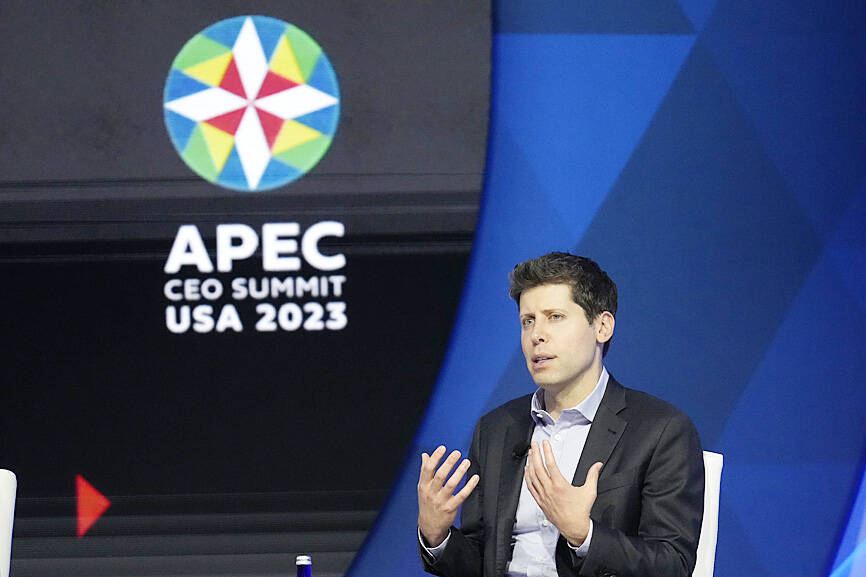OpenAI Inc’s biggest investors are pressing the company to reinstate Sam Altman as chief executive officer after the board’s stunning decision to sack him on Friday, people with knowledge of the matter said.
Microsoft Corp, the start-up’s biggest backer with a more than US$10 billion stake, is working with investors including Thrive Capital Management LLC and Tiger Global Management LLC to bring back Altman, said the sources, who asked to remain anonymous discussing private information.
As part of the effort to reinstate the CEO, investors are also pressing for the replacement of the current board, the sources said. The directors have considered stepping down, though they are currently balking at such a move, they said.

Photo: AP
The situation is fluid and final plans have not been set. If the board steps down, investors are reviewing a list of possible new directors. One contender is Bret Taylor, the former co-CEO of Salesforce Inc.
The OpenAI board has been subjected to intense criticism over its decision to remove Altman, which came as a surprise to both investors and to Altman himself.
Over the years, Altman pushed hard to change the company from a nonprofit to a commercially successful business and was the driving force behind new tools that have revolutionized the way people complete tasks from homework to coding. His ouster did not sit well with the firms that backed OpenAI.
Thrive, which was expected to lead a tender offer for employee shares, has not yet wired the money and has made it clear to OpenAI that Altman’s departure would affect its actions.
Thrive, the largest OpenAI investor aside from Microsoft, is working to reinstate both Altman and Greg Brockman, the start-up’s president, who quit on Friday in protest.
Altman is open to returning to the company, some of the sources said.
However, if he were to return, he would ask for changes in the way the company is governed, they said.
Microsoft CEO Satya Nadella has been in touch with Altman and pledged to support him in whatever steps he takes next, the sources said.
Nadella was blindsided by the board’s decision, the sources said.
Several employees, including OpenAI co-founder Brockman, have departed the company in protest following Altman’s ouster. The resignations are likely to continue, the sources said.
If he does not return, Altman has been considering launching a new venture, possibly with former staffers of OpenAI, they said.
In a statement on X, formerly Twitter, venture capitalist Vinod Khosla said that his firm wanted Altman “back at OpenAI but will back him in whatever he does next.”
In a memo to OpenAI staff on Saturday, chief operating officer Brad Lightcap said Altman’s ousting “was not made in response to malfeasance” or the company’s financial or safety practices.
The decision to force Altman out “took us all by surprise,” and he has since spoken with the board to better understand its decision, Lightcap wrote in a memo, which was viewed by Bloomberg.
“This was a breakdown in communication between Sam and the board,” Lightcap wrote, adding that Microsoft “remains fully committed” as an investor.

Nvidia Corp chief executive officer Jensen Huang (黃仁勳) on Monday introduced the company’s latest supercomputer platform, featuring six new chips made by Taiwan Semiconductor Manufacturing Co (TSMC, 台積電), saying that it is now “in full production.” “If Vera Rubin is going to be in time for this year, it must be in production by now, and so, today I can tell you that Vera Rubin is in full production,” Huang said during his keynote speech at CES in Las Vegas. The rollout of six concurrent chips for Vera Rubin — the company’s next-generation artificial intelligence (AI) computing platform — marks a strategic

Enhanced tax credits that have helped reduce the cost of health insurance for the vast majority of US Affordable Care Act enrollees expired on Jan.1, cementing higher health costs for millions of Americans at the start of the new year. Democrats forced a 43-day US government shutdown over the issue. Moderate Republicans called for a solution to save their political aspirations this year. US President Donald Trump floated a way out, only to back off after conservative backlash. In the end, no one’s efforts were enough to save the subsidies before their expiration date. A US House of Representatives vote

REVENUE PERFORMANCE: Cloud and network products, and electronic components saw strong increases, while smart consumer electronics and computing products fell Hon Hai Precision Industry Co (鴻海精密) yesterday posted 26.51 percent quarterly growth in revenue for last quarter to NT$2.6 trillion (US$82.44 billion), the strongest on record for the period and above expectations, but the company forecast a slight revenue dip this quarter due to seasonal factors. On an annual basis, revenue last quarter grew 22.07 percent, the company said. Analysts on average estimated about NT$2.4 trillion increase. Hon Hai, which assembles servers for Nvidia Corp and iPhones for Apple Inc, is expanding its capacity in the US, adding artificial intelligence (AI) server production in Wisconsin and Texas, where it operates established campuses. This

US President Donald Trump on Friday blocked US photonics firm HieFo Corp’s US$3 million acquisition of assets in New Jersey-based aerospace and defense specialist Emcore Corp, citing national security and China-related concerns. In an order released by the White House, Trump said HieFo was “controlled by a citizen of the People’s Republic of China” and that its 2024 acquisition of Emcore’s businesses led the US president to believe that it might “take action that threatens to impair the national security of the United States.” The order did not name the person or detail Trump’s concerns. “The Transaction is hereby prohibited,”